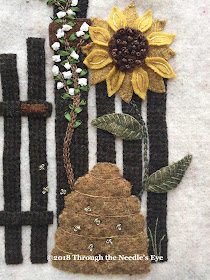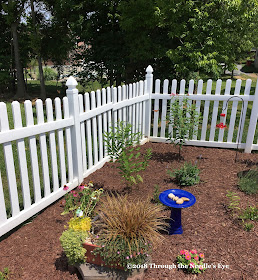
Who doesn't love a monarch butterfly? It reigns over all in its species; well, at least its name implies royalty. But indeed, it is a beauty to behold. This week, we add to our
In the Garden series with a monarch and a butterfly bush bloom. That, of course, sent me (Teri) on a quest to search through my photos to see if I had any suitable models for my butterfly. Alas, I had none perched on a butterfly bush, but a couple on lantana blooms—enough to get me started. So we hope you will enjoy the latest flower in our garden, along with its visiting monarch!

This past weekend, at
Primitive Homespuns Wool & Needleworks, we gathered in class and stitched some lovely blossoms to begin our butterfly bush blooms, and made some headway creating butterflies, as well. Here are some highlights of this block.
First, I appliquéd the stems and leaves with matching thread and then appliquéd a piece of purple wool for the background of the blossoms. I realized after I got started that the wool I had was a bit dark, so I would recommend using a lighter wool, so you can stitch the blossoms a bit less densely if you choose.
A backstitch creates the center vein, with feather stitches on either side. I didn't use a strongly contrasting green thread, but you might want to create more distinction.
To create the blossoms, I used 7mm silk ribbon, 4mm silk ribbon a shade darker, and floss for the tips. With the ribbon, I made French knots, but after I wrapped the ribbon around the needle, I took a couple of running stitches before taking the needle to the back, as pictured above.

When I do knots, I like to use a pillow. That way I can place the needle into the pillow, freeing both hands to adjust my threads or ribbon and pull them as taut as I want, and in this case, to adjust the petals created by the running stitches. Then, when I pick up my work from the pillow, I can hold it at the base of the needle when pulling it to the back, which creates a smoother knot. It is important to note here that since we are working with ribbon, a chenille needle is needed, so we can't wrap the ribbon too tightly, or it will be difficult to pull that wide eye through to the back. And don't expect every single knot to look the same—each will be as unique as each blossom on a real butterfly bush! Embrace the uniqueness.


I created these blossoms randomly, with more of the lighter and wider ribbon at the bottom, mixed gradually with the darker and thinner ribbon toward the middle, and finally blending and finishing with regular French knots using all six strands of floss at the tip of the flower. I would caution you to be mindful that if you pack the knots really closely together at first, it's hard to spread them out after you've started. (Ask me how I know.) With the lighter purple wool in the back, it would be fine to spread your blossoms out a bit. You can always fill in gaps with more knots later if you want it to be denser, but you probably won't want to take out your ribbon knots.

To stitch the butterfly, I cut two pieces of wool in the shape of the butterfly; I set one piece aside for the back and placed the other on a piece of muslin while I embroidered it. My iPad was primed with a photo that I followed as I embroidered. (The pattern gives you the design to stitch, so you don't have to create it as you go.) I used chain stitches to separate the top and bottom wings, and stem and straight stitches for the rest of the design on the wings.
After all the black lines were embroidered on the wings, I did the body. When I stitched it, I started with the turkey work and then filled in with bullion stitches. The better way is definitely to stitch the bullions first, and fill in with turkey work, which was what we did in class.
When I trimmed the turkey work, I left the threads around the body longer but trimmed the threads toward the bottom of the section very closely. White French knots on the sides of the bullion knots add detail to the body.
After trimming the muslin to the shape of the butterfly, I backed it with the other butterfly-shaped piece of wool and did a dense blanket stitch in black all the way around. To create the dots, I did a running stitch with white thread through the black blanket stitching around the edge, burying the knot between the layers. A few random straight stitches in pale yellow added the rest of the accents.
A black flower pistil folded in half and stitched to the back of the head creates the antennae.
I attached the butterfly to the flower by taking a few stitches with black thread through the center of the body. The wings are left free to "fly."
Our wonderful class stitching butterflies!

As I was writing this post, I realized that I had no good photos of a butterfly bush. My neighbor has just planted a beautiful butterfly garden, so I asked her if I could take a picture of her butterfly bush. When I was thanking her for the photo, I told her the only thing that was missing was the monarch.
She responded with a photo that she took of her newly planted garden with a monarch in flight, right next to the butterfly bush! How timely and perfect. Thanks, Joni!!
Photo by Joni Bittner
I cropped it to zoom in on the butterfly—isn't it lovely?!
The pattern for the Monarch and Butterfly Bush is now available on our website, If you haven't joined us In the Garden yet, we'd love for you to pay a visit. Maybe you can stitch your own garden!
All the patterns are available on our website (www.needleseyestories.com), and the hard copies of the patterns include any ribbon needed to complete the block. To read more about our other blocks in the series, click on the links below.
 Because of my trip to Europe in August, we took a hiatus from our Block of the Month, but we are back to finish this quilt! On Sunday, I (Teri) taught the class on our newest block, Garden Gate, at Primitive Homespuns Wool & Needleworks in Frederick, MD. As always, we had lots of fun as we reviewed the techniques used to create this block. And the shop has just moved into a larger building, so we enjoyed a bit more room in which to stitch! A happy respite from our rainy day.
Because of my trip to Europe in August, we took a hiatus from our Block of the Month, but we are back to finish this quilt! On Sunday, I (Teri) taught the class on our newest block, Garden Gate, at Primitive Homespuns Wool & Needleworks in Frederick, MD. As always, we had lots of fun as we reviewed the techniques used to create this block. And the shop has just moved into a larger building, so we enjoyed a bit more room in which to stitch! A happy respite from our rainy day. 















































